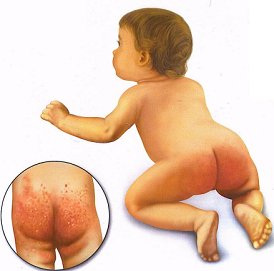Big C Discount Drugs Health Information
Diaper Rash

Inflammation in the Diaper Area
Diaper rash is an inflammation of the skin in the diaper area, leading to redness, tenderness, and scaling. It it most common in babies younger than 12 months. Plastic pants covering a cloth diaper can create the warm, moist conditions that may cause inflammation with exposure to urine and feces. Often, baby wipes or the soaps or fabric softeners used to launder cloth diapers can cause tender skin to become irritated.Most cases of diaper rash are never seen by a doctor, since the condition is easily treatable by making a few simple changes in routine. More frequent diaper changes and letting the baby sleep with an open diaper help to clear up a simple case of diaper rash. Cleaning the area with warm water alone or with warm water and a mild soap, along with the use of a moisture-barrier agent such as zinc oxide or petroleum jelly to protect skin, will usually clear up uncomplicated diaper rash within a few days.
Parents should consult a doctor if the rash does not improve after three days of home treatment, if the child develops a fever, or if the rash has blisters or sores or spreads beyond the diaper area.
Easily Treatable with Changes in Routine Common Causes of Diaper Rash
Common Causes of Diaper Rash
It is not known exactly how many babies suffer from diaper rash, because most cases are treated at home without the need for a doctor's visit. A rash in the diaper area is not an unusual problem in very young children and typically is not serious. The most likely culprit in the development of diaper rash is irritation from contact with urine or feces in a soiled diaper. Diarrhea is a common cause of uncomplicated diaper rash, since feces are more irritating than urine to the skin. As a baby's diet is modified, changes occur in the frequency and makeup of feces. Therefore, a diaper rash can often be seen when a baby begins to eat solid foods or when a new food is added. Other causes of diaper rash include baby wipes, new soaps or fabric softeners used to launder cloth diapers, certain brands of disposable diapers, and baby powders or lotions used during diaper changes. Tight-fitting diapers or plastic pants can tub against tender skin and make it irritated and inflamed. The use of plastic diaper covers over cloth diapers can also increase the moisture and temperature in the diaper area, providing an ideal environment for diaper rash to develop.Although most diaper rashes are simple skin irritations, in some cases, a bacterial skin infection or a yeast infection is the cause. Yeast infections are especially common in babies taking antibiotics or whose mothers breast-feed while taking antibiotics. These infections usually appear as bright red rashes in the skin creases of the diaper area, sometimes with small dots in the area. A rash in the diaper area can also be caused by eczema or allergic dermatitis, but in these cases, the rash is usually present on other areas of die body as well. Diaper rashes caused by bacteria, yeast, or allergic conditions will not improve with simple changes in diapering or with the use of over-the-counter skin protectants. A doctor should be consulted if a diaper rash doesn't begin to improve within three days of treatment at home, if the baby develops a fever, if the rash has pimples, blisters, or leads to broken skin, or if it spreads beyond the diaper area.
Remedies for Diaper Rash
Uncomplicated skin irritation of the diaper area is usually easy to control by making a few changes in daily routine and using a barrier cream (available without a prescription). Increasing the number of daily diaper changes and allowing the baby to sleep with an open diaper can help clear a mild diaper rash quickly. Gently cleaning the skin with warm water and mild soap (if necessary) after each diaper change is preferred over the use of disposable wipes, which often contain irritants and perfumes. Patting the area dry with a towel and loosely fastening the diaper will also help prevent moisture buildup. Babies who wear cloth diapers and plastic pants may benefit from a switch to diaper liners, breathable diaper covers, or disposable diapers until the rash clears or to prevent future diaper rashes. The use of a diaper rash medication with a moisture-barrier agent such as zinc oxide or petroleum jelly will help protect skin from irritants as the rash heals. Most doctors do not recommend the use of talcum or cornstarch powders for babies; talc can be inhaled into the baby's lungs, and cornstarch may make yeast infections of the skin worse.Ask your pharmacist if you have questions about the best nonprescription product for your baby's diaper rash.
